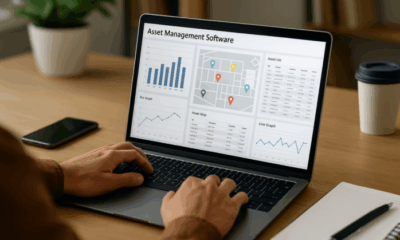Scale Your Business
How Smart Entrepreneurs Cut Financial Chaos in Half with One Simple Switch
The major problem with manual expense processes is that entrepreneurs often do not know what has happened until it’s too late

Big companies and businesses have realized that spreadsheets and manual tracking do not work in this digital and ever-evolving business era. As costs are increasing, teams work remotely, and compliance is stronger, managing expenses has become tricky.
That’s the reason a reliable expense management software is necessary in modern financial strategy.
Now, businesses are changing their internal processes because digital tools have made handling expenses more efficient for everyone from CFOs to operational leads. In this article, we will review the reasons behind the importance of using expense management software.
1. Real-Time Visibility helps with Better Financial Choices.
The major problem with manual expense processes is that entrepreneurs often do not know what has happened until it’s too late. Because finance teams rely on outdated information, issues about overspending may not be obvious until it is too late.
The solution from expense management software is live tracking and automatic updates.
Financial teams and managers can view company spending right away, notice any trends, and modify the budget in advance with expense management software.
2. Automation reduces errors and also saves time.
There is no secret that mistakes happen more often when data is typed in manually. Both miskeyed amounts and duplicate reimbursements end up taking a lot of time to fix together.
Today’s expense platforms handle all of the steps automatically.
- Employees take pictures of their receipts using their phones.
- Expenses are received in both automatic and manual categories and are checked against the chosen policies.
- All permission requests are routed automatically as soon as they are created.
- Reimbursements are paid out as decided
You’ll see less confusion, fewer errors, and more satisfied teams.
3. It Becomes Easy to Enforce Policy
Let’s admit it: dealing with company expense policies by hand is a pain. Should employees book first-class tickets by mistake or order more food than they should, rules tend to be ignored.
Enterprise-level expense management tools allow organizations to include their own rules in the system. So, every claim that comes in is automatically verified.
Because out-of-policy expenses are flagged right away, you need less supervision, and your business follows a strict financial practice.
4. Increased Transparency Builds Trust
Nobody wants to put in extra effort to receive reimbursements. Leaders don’t want the worry of whether expense reports are correct. It’s not something finance teams want to do, spend time checking things that could be generated automatically.
Everyone can see what’s going on due to the new central application.
- Employees can see the current status of their reimbursements at any time
- Managers are able to see a full history of actions.
- You can get a clear and sorted report with a few mouse clicks in the finance system
Being so open helps everyone trust one another and reduces the chances of friction between different areas of the company.
5. Strategic Insights from Clean and Orderly Data
Wise companies turn to data to improve and expand, and expense data is especially valuable. These platforms don’t only keep your receipts; they use every expense to make data.
These tools support various tasks such as identifying top vendors and tracking budget checks by offering specific reports and dashboards.
- Budget adjustments
- Forecasting
- Vendor negotiations
- Team-specific spending policies
We no longer have to make guesses about our finances. Data helps the strategy process in software development.
6. Seamless Integration with Accounting Software
A significant plus of today’s software comes from. It gets along with other technologies. The main platforms connect straight to your accounting software, ERPs, or payroll tools.
As a result, you write details only once, are less likely to make mistakes, and all parts of your financial ecosystem work together. If Clyr’s expenses are connected automatically with your general ledger, dealing with reconciliation becomes simple.
How Managing Expenses is Easier with Software for People?
As remote and hybrid work models grow, controlling and keeping track of employee expenses throughout the globe and across time zones has become a big challenge. By providing centrally managed systems that can be used by several parties, such tools fill this gap.
Submit Anywhere, Anytime
Employees are able to raise expenses from any place using mobile apps or online portals. Managers can go through and sign off on requests immediately, even if they are away from the office.
Similar Operations at Different Stores
They help all staff follow the same guidance, no matter where they work, which promotes fairness and compliance.
Reduction in Untraceable & Unapproved Expenses
Fraud and errors are more likely with manual systems. A current expense system recognises odd transactions at the start, making it less likely for violations to happen.
They use audit trails and digital records. The actions of every employee are noted so that finance teams can check every reimbursement or transaction. It helps internal auditors as well as those who do regulatory and external audits.
Bottom Line
For any business that aims to cut expenses, comply with regulations, and become efficient, using expense management software is necessary.
Now, organizations are able to achieve real-time monitoring, fraud detection, and use expense management software to make sense of their data to support decisions.
If your business still depends on spreadsheets and emails, it’s time to take a fresh look at how you manage your accounting. Proper expense monitoring benefits your business not only by spotting outgoings, but by refining your financial system for long-term success.
Business
The Hidden Money Pit in Your Operations (and How to Use It)
See how smart asset management software is quietly saving businesses thousands in wasted time, stock, and maintenance.

Trimming unnecessary expenses and minimizing resources is a general practice in running a business effectively. Asset management software can help you achieve those goals. (more…)
Business
Why Your E-Commerce Fulfilment Is Probably Broken (And How to Fix It)
Behind every “order confirmed” is a complex fulfilment system deciding whether you gain a customer — or lose one.

E-commerce isn’t some niche anymore — it’s the backbone of retail now. But with that growth comes a problem: customers expect their stuff fast, with no headaches, and they want to know exactly where their order is at all times. (more…)
Did You Know
How to Turn a Simple Link-in-Bio Into a Powerful Brand Hub
Transform your forgotten bio link into a high-impact gateway that fuels engagement, clicks, and conversions across every social platform.

Social media is one of the greatest marketing tools in 2025. According to a recent study, some 86% of marketers globally use platforms like Facebook and Instagram for advertisements, while 94% use it for content distribution. (more…)
Scale Your Business
The Secret to Customer Loyalty No One Talks About
If you want to succeed, you must do more than simply “make the sale.”

Selling has always been challenging, but in today’s high-tech, information-saturated world, the stakes are higher than ever. Buyers are bombarded daily with offers, discounts, and freebies. They’ve become more selective, more informed, and more demanding. (more…)
-

 Shift Your Mindset4 weeks ago
Shift Your Mindset4 weeks ago11 E’s That Define Every Great Leader And Why Most People Miss Them
-

 Did You Know3 weeks ago
Did You Know3 weeks agoThe Success Patterns You Inherited (And Didn’t Notice)
-

 Entrepreneurs3 weeks ago
Entrepreneurs3 weeks agoThe Essential Skills Every Entrepreneur Needs In 2026
-

 Business4 weeks ago
Business4 weeks agoThe Hidden Money Pit in Your Operations (and How to Use It)
-

 Change Your Mindset2 weeks ago
Change Your Mindset2 weeks agoHow to Turn Your Mind Into Your Greatest Asset (Instead of Your Enemy)
-

 Change Your Mindset2 weeks ago
Change Your Mindset2 weeks agoThe Silent Skill That Makes People Respect You Instantly
-

 Life1 week ago
Life1 week ago10 Research-Backed Steps to Create Real Change This New Year
-

 Tech1 week ago
Tech1 week agoWhat’s in a Name? How to Get Your Domain Right













